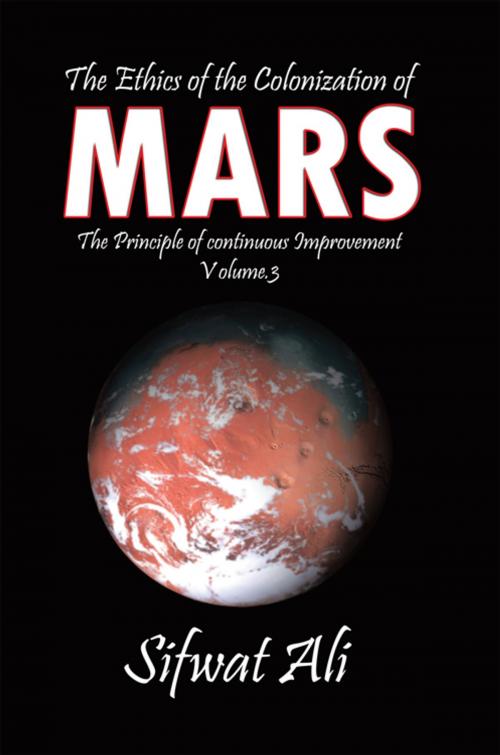The Ethics of the Colonization of Mars
Principle of Continuous Improvement Volume 3
Nonfiction, Science & Nature, Science, Biological Sciences, Ecology| Author: | Sifwat Ali | ISBN: | 9781463429126 |
| Publisher: | AuthorHouse | Publication: | August 23, 2011 |
| Imprint: | AuthorHouse | Language: | English |
| Author: | Sifwat Ali |
| ISBN: | 9781463429126 |
| Publisher: | AuthorHouse |
| Publication: | August 23, 2011 |
| Imprint: | AuthorHouse |
| Language: | English |
In order to start a discussion on any new idea, or even a proposal, a baseline must be established. It is a bit like going to a psychiatrist and asking for a diagnosis on a human subject. The psychiatrist must conduct a series of tests to determine the subjects baseline condition to see how the neurons are firing. In this chapter we will attempt to baseline our knowledge of the day and see what inspires the biological life to explore, to plan to go, and to aspire to move to a different planet.
Let us think of a giant spaceship named paradise. In this spaceship, there is a group of beings including man that has disobeyed the commander. The commander must evict this group from the paradise per the rules of the spaceship. So the commander looks for a suitable planet. Let us call this planet the Earth. The spaceship hovers over the Earth. The commander lays down the law to this group and says: get down. He then foretells them more bad news that some of you will be the enemies of the other (i.e. you will shed each others blood). At the end of the verdict he gives them a little good news: and for you, this Earth is the destination and has in it all the provisions that you will need to survive, for a time.
Well! That time is up; the time has come for the biological life on Earth to start a journey in the cosmos on its own strength, and the first steps have already been taken.
1.1 The Urge to Explore
The urge to explore and to multiply takes a Monarch Butterfly from Canada across the United States to Mexico, some two thousand miles. Its wings barely span a few inches and the body weighs not even a quarter of an ounce and yet it fearlessly soars across the Great Lakes and into the Great Plains facing every predator and hostile elements that are unthinkable from its point of view. The pilgrimage happens every year and the Day of Judgment arrives for a generation of the monarchs with the same frequency. There is grace and beauty in this exploration. It has in it a goal; it has in it full success; and it has new life. It has in it the beautiful death of the old and after the burial, the beginning of a new sacred mission of the next generation.
Then there is a species of fish collectively known as Salmon. They lay their eggs in freshwater streams typically at high latitudes. The eggs hatch and evolve in various forms staying from one to three years in their fresh water stream. Ah, it is estimated that only 10% of all salmon eggs survive to this stage. Then they move to an area of the water, in the direction of the ocean, which is more brackish than fresh allowing the body chemistry to change, to live in salt water. In science this process is called Osmoregulation. They then proceed to the open ocean and live there for as long as four years. They endure a dangerous predatory world and under heavy ocean pressures explore a new world. Close to the end, they mature sexually and when that happens they march to a sacred pilgrimage with the only sense of the regeneration of life and return to the fresh waters they came from. Some of these fresh water streams are as far away as a thousand miles both from the Pacific and in the Atlantic Oceans. Swimming a thousand miles against the currents under water is like flying a hundred thousand miles in the air. In moving back to the birth place, they journey upstream, continuously struggling, but never losing the urge to arrive at the spawning site, even as they sense (?) other members being devoured by a host of predators. After spawning, after completing their sacred journey, they gracefully die and the next generation takes over.
Let us now move to another part of the Planet Earth, deep down, in the Mariana Trench, roughly thirty six thousand feet deep in the Pacific Ocean; in fact so deep that if Mount Everest were to be submerged totally in it, all of roughly twenty-nine thousand feet, we will still have seven thousand feet of water left above it. At the bottom of the trench the pressure is roughly 15000 psi; and that is over one thousand times that of the normal atmospheric pressure. The Miracle of Life still exists without light and without the warmth of the Sun. The organism and life sustains itself from the warmth derived out of the core of the Earth. There are single-celled organisms that are thought to resemble some of the world's earliest life forms. They may be single-celled called foraminifera but there are an estimated 4,000 species living. They inhabit a wide range of marine environments, mostly on the ocean bottom. The discovery at this depth of these foraminifera living in dirt surprised even the scientists from Japans Agency for Marine-Earth Science and Technology (who led the exploration).
In order to start a discussion on any new idea, or even a proposal, a baseline must be established. It is a bit like going to a psychiatrist and asking for a diagnosis on a human subject. The psychiatrist must conduct a series of tests to determine the subjects baseline condition to see how the neurons are firing. In this chapter we will attempt to baseline our knowledge of the day and see what inspires the biological life to explore, to plan to go, and to aspire to move to a different planet.
Let us think of a giant spaceship named paradise. In this spaceship, there is a group of beings including man that has disobeyed the commander. The commander must evict this group from the paradise per the rules of the spaceship. So the commander looks for a suitable planet. Let us call this planet the Earth. The spaceship hovers over the Earth. The commander lays down the law to this group and says: get down. He then foretells them more bad news that some of you will be the enemies of the other (i.e. you will shed each others blood). At the end of the verdict he gives them a little good news: and for you, this Earth is the destination and has in it all the provisions that you will need to survive, for a time.
Well! That time is up; the time has come for the biological life on Earth to start a journey in the cosmos on its own strength, and the first steps have already been taken.
1.1 The Urge to Explore
The urge to explore and to multiply takes a Monarch Butterfly from Canada across the United States to Mexico, some two thousand miles. Its wings barely span a few inches and the body weighs not even a quarter of an ounce and yet it fearlessly soars across the Great Lakes and into the Great Plains facing every predator and hostile elements that are unthinkable from its point of view. The pilgrimage happens every year and the Day of Judgment arrives for a generation of the monarchs with the same frequency. There is grace and beauty in this exploration. It has in it a goal; it has in it full success; and it has new life. It has in it the beautiful death of the old and after the burial, the beginning of a new sacred mission of the next generation.
Then there is a species of fish collectively known as Salmon. They lay their eggs in freshwater streams typically at high latitudes. The eggs hatch and evolve in various forms staying from one to three years in their fresh water stream. Ah, it is estimated that only 10% of all salmon eggs survive to this stage. Then they move to an area of the water, in the direction of the ocean, which is more brackish than fresh allowing the body chemistry to change, to live in salt water. In science this process is called Osmoregulation. They then proceed to the open ocean and live there for as long as four years. They endure a dangerous predatory world and under heavy ocean pressures explore a new world. Close to the end, they mature sexually and when that happens they march to a sacred pilgrimage with the only sense of the regeneration of life and return to the fresh waters they came from. Some of these fresh water streams are as far away as a thousand miles both from the Pacific and in the Atlantic Oceans. Swimming a thousand miles against the currents under water is like flying a hundred thousand miles in the air. In moving back to the birth place, they journey upstream, continuously struggling, but never losing the urge to arrive at the spawning site, even as they sense (?) other members being devoured by a host of predators. After spawning, after completing their sacred journey, they gracefully die and the next generation takes over.
Let us now move to another part of the Planet Earth, deep down, in the Mariana Trench, roughly thirty six thousand feet deep in the Pacific Ocean; in fact so deep that if Mount Everest were to be submerged totally in it, all of roughly twenty-nine thousand feet, we will still have seven thousand feet of water left above it. At the bottom of the trench the pressure is roughly 15000 psi; and that is over one thousand times that of the normal atmospheric pressure. The Miracle of Life still exists without light and without the warmth of the Sun. The organism and life sustains itself from the warmth derived out of the core of the Earth. There are single-celled organisms that are thought to resemble some of the world's earliest life forms. They may be single-celled called foraminifera but there are an estimated 4,000 species living. They inhabit a wide range of marine environments, mostly on the ocean bottom. The discovery at this depth of these foraminifera living in dirt surprised even the scientists from Japans Agency for Marine-Earth Science and Technology (who led the exploration).















